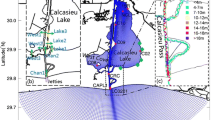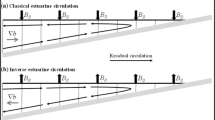Abstract
Estuarine circulation is a vertical circulation that develops along the salinity gradient in estuaries and nearshore coastal waters. Fresher, and therefore less-dense, water flows out of the estuary in the surface layer, while a deeper inflow brings water from the open sea into the estuary. This study uses 7 years of in situ current measurements and hydrographic surveys to verify that this deeper inflow has two modes: a deep inflow that intrudes along the seabed, and a shallow-inflow that penetrates into the subsurface layer. These modes show seasonal variability, i.e., the deep-inflow mode occupies almost all of the winter season, whereas the shallow-inflow mode dominates during the summer. This mode change may play a key role in oxygen and carbon dioxide (CO2) dynamics in estuaries and nearshore coastal waters. When the transition from deep- to shallow-inflow begins in spring, a cold water mass forms on the seabed in the upper estuary. This cold water mass is isolated from heating sources and oxygenated water; consequently, the cold water mass becomes hypoxic and accumulates both inorganic nutrients and CO2 during spring and summer. When the transition from the shallow- to deep-inflow occurs, the CO2, which is trapped in the bottom-water, is emitted to the atmosphere. The mechanism that causes the seasonal mode change in estuarine circulation is driven by the spatial inhomogeneity in the heating or cooling of the lower layer, which generates a horizontal density gradient in the layer. This mechanism highlights the importance of temperature in estuarine dynamics, which has not been extensively studied previously.










Similar content being viewed by others
References
Banas, N.S., B.M. Hickey, P. MacCready, and J.A. Newton. 2004. Dynamics of Willapa Bay Washington: A Highly Unsteady Partially Mixed Estuary. Journal of Physical Oceanography 34: 2413–2427. https://doi.org/10.1175/JPO2637.1.
Basdurak, N.B., and A. Valle-Levinson. 2012. Influence of Advective Accelerations on Estuarine Exchange at a Chesapeake Bay Tributary. Journal of Physical Oceanography 42 (10): 1617–1634. https://doi.org/10.1175/jpo-d-11-0134.1.
Belzile, M., P.S. Galbraith, and D. Bourgault. 2016. Water renewals in the Saguenay Fjord. Journal of Geophysical Research: Oceans 121: 638–657. https://doi.org/10.1002/2015JC011085.
Burchard, H., and R.D. Hetland. 2010. Quantifying the Contributions of Tidal Straining and Gravitational Circulation to Residual Circulation in Periodically Stratified Tidal Estuaries. Journal of Physical Oceanography 40 (6): 1243–1262. https://doi.org/10.1175/2010JPO4270.1.
Chant, R.J. 2002. Secondary circulation in a region of flow curvature: Relationship with tidal forcing and river discharge. Journal of Geophysical Research: Oceans 107: 3131. https://doi.org/10.1029/2001JC001082.
Chen, C.-T.A., and A.V. Borges. 2009. Reconciling opposing views on carbon cycling in the coastal ocean: Continental shelves as sinks and near-shore ecosystems as sources of atmospheric CO2. Deep Sea Research Part II: Topical Studies in Oceanography 56: 578–590. https://doi.org/10.1016/j.dsr2.2009.01.001.
Chen, S.N., W.R. Geyer, D.K. Ralston, and J.A. Lerczak. 2012. Estuarine Exchange Flow Quantified with Isohaline Coordinates: Contrasting Long and Short Estuaries. Journal of Physical Oceanography 42 (5): 748–763. https://doi.org/10.1175/JPO-D-11-086.1.
Cheng, P., J. Mao, F. Yu, N. Chen, A. Wang, and F. Xu. 2019. A numerical study of residual flow induced by eddy viscosity-shear covariance in a tidally energetic estuary. Estuarine Coastal and Shelf Science 230: 106446. https://doi.org/10.1016/j.ecss.2019.106446.
Coastal Oceanography Research Committee. 1985. Coastal Oceanography of Japanese Island, ed. H. Kunishi. Tokyo: Tokai Univ Press.
Conroy, T., D.A. Sutherland, and D.K. Ralston. 2020. Estuarine Exchange Flow Variability in a Seasonal Segmented Estuary. Journal of Physical Oceanography 50 (3): 595–613. https://doi.org/10.1175/JPO-D-19-0108.1.
Dijkstra, Y.M., H.M. Schuttelaars, and H. Burchard. 2017. Generation of exchange flows in estuaries by tidal and gravitational eddy viscosity-shear covariance (ESCO). Journal of Geophysical Research: Oceans 122: 4217–4237. https://doi.org/10.1002/2016JC012379.
Dzwonkowski, B., P. Kyeong, H. Kyung, W.M. Graham, F.J. Hernandez, and S.P. Powers. 2011. Hydrographic variability on a coastal shelf directly influenced by estuarine outflow. Continental Shelf Research 31 (9): 939–950. https://doi.org/10.1016/j.csr.2011.03.001.
Fofonoff, N.P., and R.C. Millard Jr. 1983. Algorithms for Computation of Fundamental Properties of Seawater. Unesco Technical Papers in Marine Science 44: 1–53.
Fujii, T., T. Fujiwara, K. Sayashi, K. Yuasa, I. Noda, T. Ono, and T. Ishikawa. 2015. Generation mechanism of hypoxic water in the nearshore water overlaid with a river plume. Journal of Japan Society of Civil Engineers B2 (Coastal Engineering) 71: 1285–1290.
Fujiwara, T., L.P. Sanford, K. Nakatsuji, and Y. Sugiyama. 1997. Anti-cyclonic circulation driven by the estuarine circulation in a gulf type ROFI. Journal of Marine Systems 12: 83–99. https://doi.org/10.1016/S0924-7963(96)00090-5.
Fujiwara, T., T. Takahashi, A. Kasai, Y. Sugiyama, and M. Kuno. 2002. The role of circulation in the development of hypoxia in Ise Bay Japan. Estuarine Coastal and Shelf Science 54: 19–31. https://doi.org/10.1006/ecss.2001.0824.
Fujiwara, T., and Y. Yamada. 2002. Inflow of oceanic water into Tokyo Bay and generation of a subsurface hypoxic water mass. Journal of Geophysical Research: Oceans 107: 1–11. https://doi.org/10.1029/2000JC000749.
Geyer, W.R., and P. MacCready. 2014. The Estuarine Circulation. Annual Review of Fluid Mechanics 46: 175–197.
Giddings, S.N., and P. MacCready. 2017. Reverse Estuarine Circulation Due to Local and Remote Wind Forcing Enhanced by the Presence of Along-Coast Estuaries. Journal of Geophysical Research: Oceans 122: 10184–10205. https://doi.org/10.1002/2016JC012479.
Guo, X., and A. Valle-Levinson. 2007. Tidal effects on estuarine circulation and outflow plume in the Chesapeake Bay. Continental Shelf Research 27 (1): 20–42. https://doi.org/10.1016/j.csr.2006.08.009.
Hansen, D.V., and M. Rattray. 1966. New dimensions in estuary classification. Limnology and Oceanography 11: 319–325. https://doi.org/10.4319/lo.1966.11.3.0319.
Hickey, B.M. 2002. Coupling between the California Current System and a coastal plain estuary in low riverflow conditions. Journal of Geophysical Research: Oceans 107 (C10): 3166. https://doi.org/10.1029/1999JC000160.
Hill, A.E. 1993. Seasonal gyres in shelf seas. Annales Geophysicae 11: 1130–1137.
Houghton, R.W., R. Schlitz, R.C. Beardsley, B. Butman, and J.L. Chamberlin. 1982. The middle Atlantic Bight cold pool: Evolution of the temperature structure during summer 1979. Journal of Physical Oceanography 12: 1019–1029.
Kobayashi, S., H. Zenitani, K. Nagamoto, A. Futamura, and T. Fujiwara. 2010. Gravitational circulation and its response to the variation in river discharge in the Seto Inland Sea Japan. Journal of Geophysical Research: Oceans 115(C03009). https://doi.org/10.1029/2007JC004503
Large, W.G., and S. Pond. 1981. Open ocean momentum flux measurements in moderate to strong winds. Journal of Physical Oceanography 11: 324–336. https://doi.org/10.1175/1520-0485(1981)011.
Lerczak, J.A., and W.R. Geyer. 2004. Modeling the lateral circulation in straight stratified estuaries. Journal of Physical Oceanography 34 (6): 1410–1428. https://doi.org/10.1175/1520-0485.
Lewis, E. and D. W. R. Wallace. 1998. Program Developed for CO2 System Calculations ORNL/CDIAC-105. Oak Ridge: Carbon Dioxide Information Analysis Center.
MacCready, P. 2011. Calculating Estuarine Exchange Flow Using Isohaline Coordinates. Journal of Physical Oceanography 41 (6): 1116–1124.
MacCready, P., W.R. Geyer, and H. Burchard. 2018. Estuarine Exchange Flow is Related to Mixing through the Salinity Variance Budget. Journal of Physical Oceanography 48 (6): 1375–1384.
Nakajima, M., and T. Fujiwara. 2007. Estuarine Circulation and Hypoxic Water Mass in Osaka Bay. Bulletin on Coastal Oceanography 44 (2): 157–163.
Nidzieko, N.J., and S.G. Monismith. 2013. Contrasting Seasonal and Fortnightly Variations in the Circulation of a Seasonally Inverse Estuary Elkhorn Slough California. Estuaries and Coasts 36 (1): 1–17. https://doi.org/10.1007/s12237-012-9548-1.
Pritchard, D.W. 1952. Salinity distribution and circulation in the Chesapeake Bay estuarine system. Journal of Marine Research 11 (2): 106–123.
Pritchard, D.W. 1956. The dynamic structure of a coastal plain estuary. Journal of Marine Research 15: 33–42.
Reyes-Hernandez, A.C., and A. Valle-Levinson. 2010. Wind Modifications to Density-Driven Flows in Semienclosed Rotating Basins. Journal of Physical Oceanography 40 (7): 1473–1487. https://doi.org/10.1175/2010JPO4230.1.
Shearman, R.K., and K.H. Brink. 2010. Evaporative dense water formation and cross-shelf exchange over the northwest Australian inner shelf. Journal of Geophysical Research: Oceans 115: C06027. https://doi.org/10.1029/2009JC005931.
Stigebrandt, A., and O. Kalén. 2013. Improving Oxygen Conditions in the Deeper Parts of Bornholm Sea by Pumped Injection of Winter Water. Ambio 42: 587–595.
Taguchi, F., and T. Fujiwara. 2010. Carbon dioxide stored and acidified low oxygen bottom waters in coastal sea Japan. Estuarine Coastal and Shelf Science 86: 429–433. https://doi.org/10.1016/j.ecss.2009.07.037.
Thomson, R.E., S.F. Mihály, and E.A. Kulikov. 2007. Estuarine versus transient flow regimes in Juan de Fuca Strait. Journal of Geophysical Research: Oceans 112: 1–25. https://doi.org/10.1029/2006JC003925.
URL1: http://www1.river.go.jp/
URL2: http://www.data.jma.go.jp/kaiyou/db/tide/suisan/station.php
URL3: https://www1.kaiho.mlit.go.jp/KAN4/kaisyo/isewan/isewan_kankyo.html
URL5: http://www.isewan-db.go.jp/real_web/REAL_WEB_buoy/PointSelect/Index
Valle-Levinson, A., C. Li, T.C. Royer, and L.P. Atkinson. 1998. Flow patterns at the Chesapeake Bay entrance. Continental Shelf Research 18: 1157–1177.
Valle-Levinson, A., and R.E. Wilson. 1998. Rotation and vertical mixing effects on volume exchange in eastern Long Island Sound. Estuarine Costal and Shelf Science 46: 573–585.
Valle-Levinson, A. 2011. Classification of Estuarine Circulation. In Treatise on Estuarine and Coastal Science, vol. 1, ed. E. Wolanski and D.S. McLusky, 75–86. Waltham: Academic Press.
Wang, T., and W.R. Geyer. 2018. The Balance of Salinity Variance in a Partially Stratified Estuary: Implications for Exchange Flow Mixing and Stratification. Journal of Physical Oceanography 48 (12): 2887–2899. https://doi.org/10.1175/JPO-D-18-0032.1.
Wong, K.-C. 1994. On the nature of transverse variability in a coastal plain estuary. Journal of Geophysical Research: Oceans 99: 14209–14222.
Acknowledgements
We are grateful for the monitoring data provided and supplied by the Nagoya Research and Engineering Office for Port and Airport, Chubu Regional Development Bureau, Ministry of Land, Infrastructure, Transport and Tourism. The monthly hydrographic observations were downloaded from the home pages of the Hydrographic and Oceanographic Department, Japan Coast Guard, and Mie Prefecture Fisheries Research Institute.
Author information
Authors and Affiliations
Corresponding author
Additional information
Communicated by Neil Kamal Ganju
Key Points
- The seasonal change in the depths of the seawater inflow associated with estuarine gravitational circulation is elucidated using 7 years of in situ current measurements.
- Spatial inhomogeneity in heating or cooling in the lower layer causes a horizontal density gradient in this layer, and this induces the seasonal change in the inflow depth.
- The change in the inflow depth plays an important role in oxygen and CO2 dynamics in estuaries and nearshore coastal waters.
Rights and permissions
About this article
Cite this article
Kobayashi, S., Nagao, K., Tsurushima, D. et al. Seasonal Changes of Estuarine Gravitational Circulation: Response to the Annual Temperature Change. Estuaries and Coasts 45, 737–753 (2022). https://doi.org/10.1007/s12237-021-00991-6
Received:
Revised:
Accepted:
Published:
Issue Date:
DOI: https://doi.org/10.1007/s12237-021-00991-6




